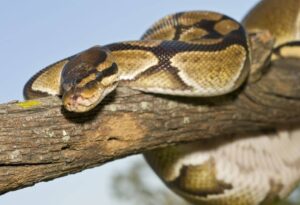The world of ball pythons, with its enigmatic coils and serene demeanor, has long captivated the curiosity of reptile enthusiasts. Among the many questions that arise in the realm of ball python care and behavior, one query stands out prominently: Do ball pythons hibernate?
Yes, ball pythons do not hibernate in the same way as some other reptiles do. In their natural habitat, they may experience periods of decreased activity during cooler seasons, but this is not true hibernation. Instead, they become less active and may seek out warmer areas to maintain their body temperature.
In captivity, ball pythons can exhibit similar behavior if environmental conditions mimic those of their natural habitat. However, they still require access to warmth and may continue to eat throughout the year if provided appropriate care.
Do ball pythons hibernate?

Ball pythons do not hibernate in the traditional sense like some other reptiles such as certain species of turtles or snakes like the timber rattlesnake. Instead, they undergo a period of decreased activity and metabolic slowdown called brumation.
During brumation, which typically occurs in response to seasonal changes in temperature and daylight hours, ball pythons may reduce their activity levels, move less, and exhibit a decreased appetite. However, they do not enter a state of deep, prolonged sleep like animals that hibernate.
Brumation allows ball pythons to conserve energy during periods when environmental conditions are less conducive to their usual activity levels. It’s important for owners to recognize signs of brumation in their ball pythons and make appropriate adjustments to their care, such as reducing feeding frequency and providing slightly cooler temperatures, to support their natural behaviors during this time.
Why understanding hibernation in ball pythons is important?
Understanding the behavior of brumation in ball pythons is crucial for several reasons:
- Health and Well-being: Brumation is a natural process for ball pythons, and understanding it allows owners to provide appropriate care during this time. Adjusting temperature, humidity, and feeding schedules can help ensure the snake remains healthy and comfortable throughout the brumation period.
- Prevention of Stress and Injury: Without proper understanding, owners may mistake brumation for illness or improper care. This misunderstanding could lead to unnecessary stress for the snake or inappropriate attempts to “wake it up,” which can be harmful.
- Reproduction: Brumation plays a vital role in the reproductive cycle of ball pythons. Understanding this behavior is essential for breeding programs, as it helps mimic natural conditions and encourage successful breeding.
- Behavioral Insights: Observing brumation behavior provides valuable insights into the natural behaviors of ball pythons. This understanding can deepen the bond between owner and pet and contribute to better overall care and enrichment.
- Preparation and Planning: Knowing when brumation typically occurs allows owners to prepare for it in advance. This preparation might involve adjusting feeding schedules, monitoring temperatures, and ensuring the enclosure is appropriately set up for the snake’s comfort during brumation.
- Veterinary Care: If a ball python exhibits unusual behavior during brumation or fails to emerge at the expected time, understanding brumation allows owners to communicate effectively with veterinarians. This communication ensures that any necessary medical care or intervention is provided promptly and appropriately.
Factors influencing hibernation in captive ball pythons
Signs that a ball python may be preparing to hibernate

Ball pythons in captivity may exhibit certain behaviors and physiological changes indicating that they are preparing to enter a brumation-like state. Here are some signs to look out for:
- Reduced Activity: Ball pythons may become less active than usual, spending more time hiding and less time exploring their enclosure.
- Decreased Appetite: As they prepare for brumation, ball pythons often lose interest in food. They may refuse meals or eat less frequently than usual.
- Seeking Shelter: Ball pythons may start to seek out hiding spots more frequently, indicating a desire to find a secure and secluded area to brumate.
- Changes in Basking Behavior: If you provide a basking spot in the enclosure, the ball python may spend less time there as it prepares for brumation.
- Weight Loss: As they reduce their activity and food intake, ball pythons may begin to lose weight in preparation for brumation. Regular weighing can help monitor their condition.
- Changes in Body Temperature: You might notice a slight drop in the snake’s body temperature as it prepares for brumation. However, this might be challenging to observe without specialized equipment.
- Increased Restlessness: Some ball pythons may become more restless in the days leading up to brumation, exhibiting pacing or repetitive movements.
- Shedding Behavior: Just before entering brumation, some ball pythons may go through a shed cycle. This shedding could be more frequent or irregular compared to their typical shedding pattern.
- Exploration of Burrowing Sites: Ball pythons may start to explore potential burrowing sites within their enclosure, indicating a desire to create a cozy and secure space for brumation.
- Seasonal Cues: Depending on the time of year and environmental conditions, ball pythons may exhibit brumation behaviors as a response to changes in daylight hours and temperature.
Not all ball pythons in captivity will enter brumation, and some individuals may not exhibit all of these signs. Additionally, if you’re uncertain about your snake’s behavior or health status, consulting with a reptile veterinarian is always recommended.


